
OBALNA BATERIJA BENEDETTO
Fort Forno je obalna utvrda blizu Barbarige koju je izgradila Austrija 1904. godine, radi obrane glavne luke svoje ratne mornarice. Utvrda se nalazila u sektoru IX Obalne regije Pula (njem. Küstenabschnitt Pola), a klasificirana je kao obalna oklopna utvrda (njem. Werk (Küstenfort) mit Panzer). Fort Forno građen je u stilu svoga vremena, u obliku prstena ojačanog dvjema baterijama, Benedetto i Caluzzi. Obalna baterija San Benedetto sagrađena je od 1898. do 1903.
Zašto nam je ova baterija zanimljiva za earthcache? Zanimljiva nam je jer na njoj možemo naći sige koje rastu na njoj.

SIGE
Siga u latinskom je sigillum, što označava kipić ili figuricu, no međunarodni naziv za sige je, speleotem (grč. sphlaion ili spelaion = špilja; jama, thema = talog) , a znači špiljski talog.
Kalcitne sige najčešći su i najznačajniji talozi u mnogim špiljama. Svojim rastom one mogu uklopiti i mnoge druge minerale, prašinu iz zraka, te organski materijal od veličine spora i zrnaca peluda do kostiju.
Sige možemo razlikovat prema obliku, te po načinu nastanja - npr. kapanjem vode, slijevanjem preko zidova, rasprskavanjem, rastom kristala na površini jezera, taloženjem u podvodnim sredinama i dr. Pojedini tipovi siga dobivaju imena obično prema morfologiji, kao npr. špiljski biseri i zavjese, te prema okolišu u kojemu su nastali, kao npr. špiljska splav i podvodne sige.
STALAKTIT
Stalaktiti su najpoznatiji tip siga. Rastu (“vise”) od stropa prema podu špilje. Mogu biti vrlo sitni ali i višemetarski, i na kraju se mogu i spojiti s podom ili pripadajućim stalagmitom, kada nastaje stup ili stalagnat .
Tipični stalaktiti imaju središnji kanalić građen od kristala vertikalno orijentiranih izduženjem, kroz koji prolazi voda, što se lijepo vidi na stalaktitnim cjevčicama (“makaroni”), te vanjski sloj od kristala radijalno orijentiranih izduženjem, izraslih okomito na središnji kanal.
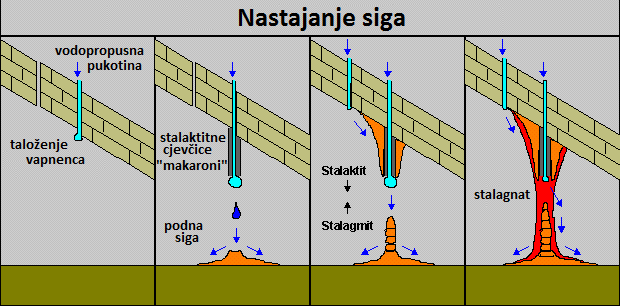
Voda, koja se procjeđuje kroz pukotine u stijenama, skuplja se na stropu špilja u obliku tankoga filma ili kapljica. Kada kapljica postane preteška naposljetku padne, a zbog izlaženja ugljikovog dioksida, na njenome rubu zaostaje sitni kalcitni prsten, ispočetka vezan za strop površinskom napetošću. To je inicijalni prsten, začetak rasta buduće cjevčice. Cjevčica raste sve dok postoji kontinuirani dotok vode. Promjer cjevčice, dakako, određen je promjerom kapljice.
Stalaktiti su naslage materijala, koji se sastoje od stijena, a vise sa stropa - uglavnom špilja, ali ponekad ih možemo naći i na zgradama.
Oni mogu nastati na betonskim konstrukcijama, kada se topivi materijal ili se materijal prenosi u vodi (kao što su minerali, blato, pijesak, lava, itd) , u vodi otopi ili se samo prenosi. Ta voda će se cijediti kroz strukturu i počinje kapati sa stropa. Kad voda dođe u dodir sa zrakom dolazi do kemijske reakcije i materijal se skuplja i stvrdnjava. S vremenom stalnim taloženjem i stvrdnjavanjem stalaktit rastu (kako je gore opisano).
Prosječna brzina rasta stalaktita je 0,13 mm na godinu. Najbrže rastu stalaktiti koje formira voda koja brzo teće i bogata je kalcijevim karbonatom i ugljičnim dioksidom, te može narasti i do 3 mm godišnje.
STALAGMITI
Stalagmiti su sige koje s poda podzemnih prostora rastu prema gore. Najrazličitijih su oblika, a nastaju kapanjem vode sa stropa ili sa stalaktita iznad njih. Obično imaju zaobljen vrh a i većega su promjera od pripadajućega stalaktita iznad. Za razliku od stalaktita, nemaju središnji kanal. Kapljica vode koja padne sa stalaktita ili sa stropa obično još uvijek sadrži nešto hidrokarbonata u otopini. Tijekom pada kroz zrak, a posebno pri udaru o pod, iz kapljice se oslobađa CO2 te se taloži CaCO3.
Visina s koje kapljica pada, brzina kapanja, isparavanje i količina hidrokarbonata u otopini određuju veličinu i oblik stalagmita. Masivni stalagmiti nastaju pri brzom kapanju, kada se taloženje odvija i po bokovima stalagmita koji tada raste i u širinu. Kod sporijega kapanja većina taloga ostaje na vrhu stalagmita koji postaje visok i tanak. Karbonatni slojevi okomiti su na smjer rasta stalagmita (talože se kao hrpa palačinki). Kada voda kapa s niskog stropa, slojevi koji grade stalagmit obično su ispupčeni prema gore, a u slučajevima kada voda kapa s visokih stropova, slojevi su udubljeni, odnosno ispupčeni prema dolje.
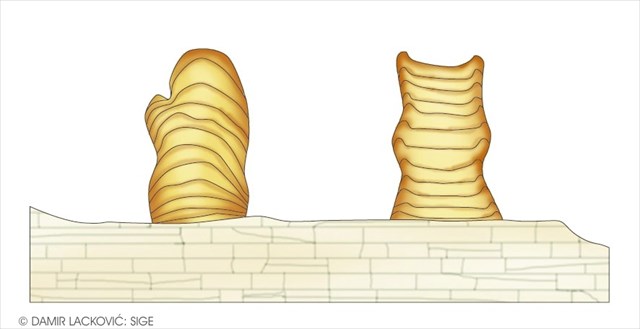
Karakterističan oblik i građa stalagmita nastalog kapanjem vode s niskog stropa (lijevo) i s visokog stropa (desno)
Da bi mogli logirat Earthcache postavit ću Vam nekoliko pitanja, a Vi mi pošaljite odgovore na mail, ne morate čekati moj odgovor već slobodno logirajte, ako nešto nije u redu kontaktirat ću Vas.
Molim da NE dodirujte stalaktite jer su vrlo krhki!
1. Na početnim koordinatama (drugi prozor), procijenite duljinu najdužeg stalaktita? NE DODIRUJTE STALAKTITE!
2. Što bi se moglo naći da raste ispod stalaktita? Promotrite doljnji dio prozora ispod stalaktita što vidite, objasnite svojim riječima što se tu događa?
3. Što će se dogoditi ako se ta stvar poveže sa stalaktita?
4. Popnite se kamenim stubama, uđite u 3. prostoriju na lijevoj strani i istražite gdje sve vidite stalaktite? Koje su boje? Objasnite svojim riječima što mislite zašto su takve boje bez obzira gdje se nalaze.
5. Otiđite u prostoriju sa spoiler slike i promotrite stalaktite koje ćete ovdje vidjeti. S obzirom na brzinu rasta, spomenuto u tekstu, koliko dugo mislite raste najduži stalaktit kojeg ovdje vidite? Da li se to čini normalnim, ili to naslučuje da rastu brže? MOLIM DA NE DIRATE STALAKTITE!
6. Promatrajući stalaktite na svim mjestima dobro ih promotrite i objasnite svojim riječima što vidite. Dali su vrhovi tih stalaktita šiljastim ili zaobljena ili ?
Uživajte u istraživanju ovog predivnog objekta koji odolijeva zubu vremena!
UPOZORENJE: Ulazite na vlastitu odgovornost!

BATTERIE BENEDETTO
Fort Forno is a coastal fort near Barbariga built by Austria in 1904, to defend their main port of the Navy. The fort was in the sector IX Coast region Pula, and is classified as coastal armored fortress. Fort Forno is built in the style of his time, a ring-shaped reinforced by two batteries, Benedetto and Caluzzi. Coastal batteries San Benedetto was built from 1898th to 1903rd.
Why is this batterie interesting for earthcache? It is interesting because in it we can find speleothems that grow here.

SPELEOTHEM
Speleothem (Gr. Sphlaion or spelaion = cave, cave, thema = precipitate) means cave sediment.
Calcite speleothems are the most common and most important precipitates in many caves. When there growth they can incorporate many other minerals, dust from the air, and organic material the size of spores and pollen grains of the bone .
Speleothems can be differing according to the form and way of occurrence - eg. dripping of water, pouring over the walls, spraying, growing crystals on the surface of the lake, sedimentation in underwater environments and others. Some types of speleothems are named according to the usual morphology, for example, cave pearls and drapes, and the environment in which they are incurred, such as cave raft and underwater flowstone.
STALACTITE
Stalactites are the most famous type of speleothems. They grow ("hang") from the ceiling to the floor of the cave. They can be very small but also several meters large, and in the end can also be connected to the floor or the associated stalagmite, when arise a pillar or stalagnat.
Typical stalactites have a central canalicular constructed of crystal vertically oriented elongation, through which the water passes, which is nice to see on stalactite tubes ("macaroni"), and outer layer of crystals radially oriented elongation, who rise vertically on the center channel.
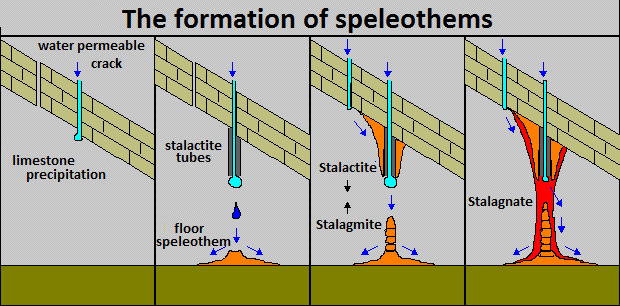
The water which is drained through the cracks in the rocks, collect at the ceiling caves in the form of a thin film or droplets. When droplets become too heavy finally falls, and for exiting of carbon dioxide, on her edge lag behind tiny calcite ring, from beginning tied to the ceiling with surface tension. This is the initial ring, the beginning of growth future tubes. Slug grows until there is a continuous flow of water. The diameter of the tube, of course, is determined by the diameter of the droplets.
The average growth rate of stalactite is 0.13 mm per year. The fastest growth of stalactites is formed by fast-flowing water and is rich in calcium carbonate and carbon dioxide, and can grow up to 3 mm per year.
STALAGMITE
Stalagmites are speleothems that are growing up from the floor of underground space. There are different in shape, and grow from dripping water from the ceiling or from the stalactites overhead. They usually have a rounded tip and are larger in diameter than the corresponding stalactites above. In contrast to stalactites, they have not a center channel. A drop of water that falls from the stalactite or from the ceiling usually still contains some hydrocarbons in solution. During the fall through the air, especially on impact on the ground, from droplets released CO2 and precipitated CaCO3.
The height from where the droplets fall, the speed of dripping, evaporation and the amount of hydrocarbons in solution determine the size and shape of the stalagmite. Massive stalagmites are formed during fast dripping, when deposition takes place and the sides of the stalagmite which then grow in width. With slower drip most sediment remains at the top of the stalagmite which becomes tall and thin. Carbonate layers are perpendicular to the direction of growth of stalagmites (precipitated as a bunch of pancakes). When the water drip from the low ceiling, layers that build stalagmite usually protruding upward, and when the water drip from high ceilings, layers are concave or convex downward.

The characteristic shape and structure of stalagmites formed drip water from low ceiling (left) and from high ceiling (right)
In order to log this Earth Cache I will ask you several questions and you should send your answers to my e-mail. You don’t have to wait for my confirmation, feel free to log the find as son as you send your answers. If there are problems with your answers, I will contact you.
Please DO NOT touch the stalactites as they are pretty fragile!
1. At the posted coordinates (second window), estimate the length of longest Stalactite you see here. DO NOT TOUCH THE STALACTITES!!
2. What would you normally expect to find growing below a stalactite? Observe the lower part of the window below under the stalactites what you can see, explain in your own words what's going on here?
3. What happens if this object connects with the stalactite?
4. Go up the stone stairs, enter the 3rd room on the left side and explore where all you can see stalactites? What color? Explain in your own words what you think why are they in that color, regardless of where they are located. ?
5. Go in to the room from where is taken the spoiler picture and consider the stalactites that you see here. Given the growth rate mentioned above, how long do you think the longest one has been growing here? Does this seem likely or does this suggest these objects are growing at a faster rate? DO NOT TOUCH THE STALACTITES!!
6. Observing the stalactites at all the places consider and explaine in your own words what you see. Are the tips of these stalactites pointy or rounded or ? DO NOT TOUCH THE STALACTITES!!
Enjoy to exploring this beautiful building which resists ravages of time!
WARNING: You enter on your own risk!

KÜSTENBATTERIE BENEDETTO
Das Fort Forno liegt an der westlichen Küste der Halbinsel, zwischen Pula und Rovinj. In diesem Strandabschnitt befinden sich noch die ehemalige Mörserbatterie Calutzzi und die Küstenbatterie Benedetto, sowie der Unterkunfts/Kasernenbereich dieser drei Anlagen. Baubeginn des Forts war 1902 und 1914 wurde es fertiggestellt. Küstenbatterien Benedetto wurde von 1898. bis1903. gebaut.
Warum ist diese Küstenbatterie als Earthcache interessant? Interessant ist sie weil in ihr wir Tropfsteine finden können die hier wachsen.
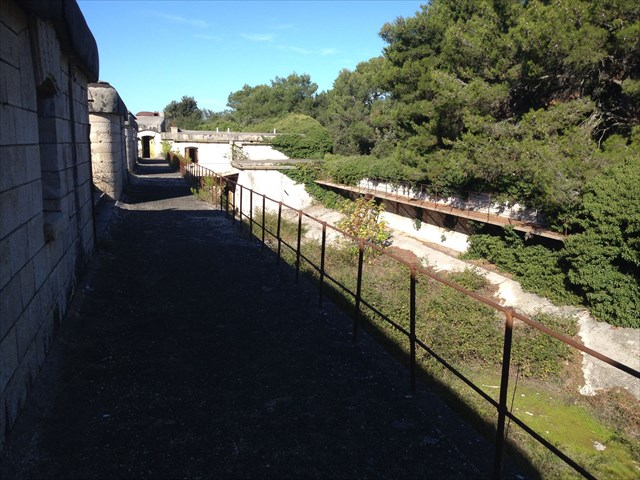
TROPFSTEINE/SINTER
Höhlensinter (Gr. Sphlaion oder spelaion = Höhle, thema = Materie ) bedeutet Höhle Sediment.
Calcit Höhlensinter sind die häufigsten und wichtigsten Ablagerungen in vielen Höhlen. In ihrem Wachstum können sie viele andere Mineralien, Staub aus der Luft, und das organische Material, von der Größe der Sporen und Pollenkörner bis auf die Knochen aufnehmen.
Die Höhlensinter können wir je nach der Form und der Art und Weise der Entstehung unterscheiden - zB. Abtropfen von Wasser, fließen über die Wände, Verspritzen, Wachstum von Kristallen auf der Oberfläche des Sees, Sedimentation im der Unterwasser Umgebungen und anderes. Einige Arten von Höhlensinter werden entsprechend der üblichen Morphologie genannt, zum Beispiel Höhlenperlen und Vorhänge, und nach der Umgebung in der sie entstehen, zum Beispiel Höhlen Flöße und Unterwasser Höhlensinter.
STALAKTITE
Stalaktiten sind die bekanntesten Art von Tropfsteinen. Sie wachsen ("hängen") von der Decke zum Boden der Höhle. Sie können sehr klein sein, aber auch mehrere Meter groß, und am Ende können sie auch mit dem Boden oder dem entsprechenden Stalagmiten sich verbinden, so entsteht eine Säule oder Stalagnat.
Typische Stalaktiten haben einen zentralen Kanal aus Kristall der vertikal orientiert verlängert ist, durch den das Wasser läuft, was man schön bei den Stalaktiten Röhren sehen kan ("Makkaroni"), und haben eine äußere Schicht aus Kristallen radial orientiert verlängert, die vertikal auf den Center-Kanal wächst.

Das Wasser, das durch die Risse in den Felsen sickert sammelt sich an der Höhlen Decke in Form eines dünnen Films oder Tröpfchen. Wenn das Tröpfchen schließlich zu schwer wird fällt es, und wegen dem austreten von Kohlendioxid, an ihrem Rand bleibt ein winziger Calcit Ring, der zunächst mit der Spannung Deckenfläche angebracht ist. Das Röhrchen wächst bis es ein kontinuierlichen Strom von Wasser gibt. Der Durchmesser des Röhrchens wird durch den Durchmesser des Tröpfchens bestimmt.
Die durchschnittliche Wachstumsrate von Stalaktit beträgt 0,13 mm pro Jahr. Das schnellste Wachstum der Stalaktiten wird durch schnell fließendes Wasser gebildet und ist reich an Kalziumkarbonat und Kohlendioxid und kann bis zu 3 mm pro Jahr wachsen.
STALAGMITE
Stalagmiten sind Höhlensinter die vom Boden des unterirdischen Raum nach oben wachsen. Sie sind verschiedene Formen und endstehen beim Tropfen des Wassers von der Decke oder aus dem Stalaktiten über ihnen. Sie haben meist eine abgerundete Spitze und sind im Durchmesser größer als die entsprechenden Stalaktiten oben. Im Gegensatz zu Stalaktiten, haben sie keinen zentralen-Kanal. Der Wasser Tropfen der von den Stalaktiten oder von der Decke fällt enthält, in der Regel nach wie vor, einige Kohlenwasserstoffe in der Lösung, währen des Falls durch die Luft, vor allem beim Aufprall auf dem Boden, aus dem Tröpfchen werden CO2 freigesetzte und CaCO3 wird abgelagert.
Die Höhe aus der das Tröpfchen fallt, die Geschwindigkeit des Tropfens, Verdampfung und die Menge an Kohlenwasserstoffen in der Lösung bestimmen die Größe und Form des Stalagmiten. Massive Stalagmiten entstehen bei schnellem tropft, wenn die Ablagerung an den Seiten des Stalagmiten erfolgt, die dann in die Breite wachsen. Mit langsameren Tropfen bleibt die meisten Sediment an der Spitze des Stalagmiten, die groß und dünn werden. Carbonat Schichten sind senkrecht zur Richtung des Wachstums von Stalagmiten (akkumulieren sich als ein Haufen von Pfannkuchen). Wenn das Wasser von einer niedrigen Decke tropft, sind die Schichten des Stalagmiten in der Regel konkav nach oben, und wenn das Wasser von hohen Decken tropft sind die Schichten konvex nach unten.

Die charakteristische Form und Struktur von Stalagmiten die sich bilden von tropfendem Wasser von einer niedriger Decke (links) und einer hohen Decke (rechts)
Zum Logen dieses Earthcaches habe ich für Sie ein paar Fragen. Bitte die Antworten auf mein E-mail Adresse schicken. Sie müssen nicht auf meine Antwort warten, sondern können gleich Loggen, wenn was nicht korekt ist werde ich Sie kontaktieren.
Bitte berühren Sie nicht die Stalaktiten, weil sie sehr zerbrechlich sind!
1. An den Anfangskoordinaten (zweites Fenster), schätzen die Länge der längsten Stalaktiten. BITTE NICHT berühren die Stalaktiten!!
2. Was kann man finden das wächst unter den Stalaktiten? Beobachten Sie den unteren Teil des Fensters unter den Stalaktiten, was können Sie sehen, erklären Sie in Ihren eigenen Worten, was hier los ist?
3. Was passiert, wenn sich diese Sache mit den Stalaktiten verbindet?
4. Gehen Sie die Treppe nach oben, treten Sie links in den dritten Raum hinein und erkunden Sie wo Sie alles Stalaktiten sehen können? Welche Farbe sind sie ? Erklären Sie mit eigenen Worten, was Sie denken warum sind sie in dieser Farbe unabhängig davon, wo sie sich befinden. BITTE NICHT berühren die Stalaktiten!!
5. Gehen Sie in den Raum vom Spoiler Bild und betrachten Sie die Stalaktiten, die Sie hier sehen. Bei der Geschwindigkeit des Wachstums, die im Text erwähnt ist, wie lange denken Sie das die längsten Stalaktiten wachsen, die Sie hier sehen? Scheint es normal, oder zu vermuten, dass sie schneller wachsen? BITTE NICHT berühren die Stalaktiten!!
6. Beobachten Sie die Stalaktiten auf allen Orten und erklären Sie mit eigenen Worten was sehen Sie. Sind die Spitzen dieser Stalaktiten spitz oder abgerundet oder? BITTE NICHT berühren die Stalaktiten!!
Genießen Sie im erforschen dieses schönen Gebäudes das der Verwüstung der Zeit widersteht!
ACHTUNG: Betreten auf eigene Gefahr!
Izvor: wikipedia,
speleologija.eu
goodearthgraphics.com
seilnacht.com
Souvenir/Banner:
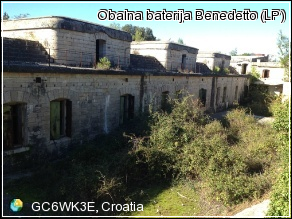
Code: <a href="https://coord.info/GC6WK3E" ><img src="https://s3.amazonaws.com/gs-geo-images/4a344f2c-058d-43ca-a453-e9b029074155.png" /></a>
